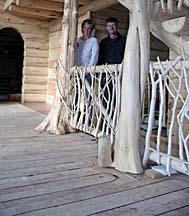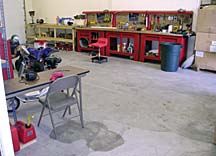
The first stop involved Steve Ebels, owner of Golden Rule Heating in Falmouth. Ebels had recently completed the installation of a radiant heat system in a 2,600-square-foot home in nearby McBain.
The second stop was to visit with Mike Norgan, owner of Phillips & Norgan Plumbing & Heating of Bay City. Norgan showed off a radiant flooring system that his company installed in a commercial building in an industrial park on the outskirts of Bay City.

The Richardson Home
Tom and Juanita Richardson were saddened when their home on 70 acres of family land burned down three years ago. But it marked the beginning of a project that has been a labor of love ever since.For the past two years, the Richardsons have meticulously assembled their dream home on the banks of the Clam River in this picturesque northern Michigan setting. Local Amish builder Richard Troyer framed in the log home using timber from the McBain area. The Richardsons have been adding finishing touches as their budget has allowed, often using branches from the neighboring woods to provide decorative touches and handrails for the two-story home.
Tom has spent a great deal of time on the Internet, researching the various appliances and systems that he wanted in the home. Juanita was impressed with the feel and efficiency of radiant heating and decided it was what they needed for the home.
“I can hardly wait to have the heated floors this winter,” Juanita said. She noted that Tom did his homework when looking for an installing contractor, too.
“Tom knew Steve and felt very confident in his work,” she said. “We got bids from three or four other contractors, but Tom felt comfortable with Steve. He won’t go into any business deal until he gets to know the other person.”

Ebels detailed the steps involved in installing a radiant heat system.
“We first lay down insulation foam. Then we staple down the tubing on specific centers. We hook up the manifold, air test it, and then the concrete is poured. After it is poured, we rough in the heating lines, hang the equipment, and hook up the lines.”
Ebels said that one of the biggest challenges was determining the heat loss in the log home. “It is hard to determine the RH factor of these big logs,” he noted. Another consideration involving heat loss/gain was the location of the home on the property. The home is turned slightly to the southeast, to help with heat gain during the day.
The radiant floor in the great room will provide much of the heat for the home, generating up to 30 Btu per square foot when the cold northern Michigan winter blows in. It can produce as little as 2 Btu per square foot in milder weather. The system is “always on” and heats up on demand, Ebels said, depending on outside temperatures.

He also said that the Richardsons have the option of converting from their current propane gas to an outdoor hot water boiler if energy costs rise drastically. “If the costs get too high, we can seamlessly add the hot water boiler to the existing hydronic system,” he said.
“The radiant system is pretty comparable to gas forced air,” Ebels said. “The floor can be up to temperature in a couple of hours, but while it is heating up, every object in the room is heating up, too.”
“We want comfort and efficiency,” said Juanita. “We will be very happy with radiant.”
Ebels said that the radiant market is growing in his rural area, but he still needs help getting the word out about his services. He recently signed up with ServiceMagic.com, a Web portal that acts as an informational site and referral source for HVACR contractors.
“I already got one solid lead from a lady in the Traverse City area,” he said. “And the lead only cost me $18.”

Motorfun Distributing Co.
Mark Hoffman owns a number of different buildings in his industrial park on the outskirts of Bay City. He rents out the buildings to local businesses for use as office space or warehousing. Hoffman knows the value of radiant heat. He learned about it from Mike Norgan, who installed radiant heat in a number of pole barns that Hoffman owns.That’s why it is no surprise that Hoffman turned to Norgan to in-stall radiant systems in his rental commercial buildings. During The News’ visit, Norgan conducted a tour of one building that is being used as a distribution point for motorized scooters and four-wheel drive vehicles, some very hot items in today’s retail recreational motor vehicle markets.
“The franchisee had to move from across the street to this bigger warehouse because sales have been so good,” said Norgan.
To satisfy the heating needs of the 2,800-square-foot building and its occupants, Norgan used the same equipment as Ebels did in the Richardson home — a Viessmann Vitodens boiler and PEX tubing laid in the cement flooring.
The office area, shop, and storerooms are heated by the radiant floor system. This is especially useful for some of the employees.

Motorfun president Dave LeRoux is impressed with radiant heating for a couple of reasons. “There is definitely a significant saving in energy costs, and it is more comfortable heat,” he said.
Norgan and his father Clayton took over the four-person business in 1996. Norgan said he has been working in hydronic heating “for as long as I can remember.” He commented that an “old boss suggested doing hydronic heating when everyone else was doing forced air. Now I can be considered an expert in this area. Radiant heat is something different. People talked about it way back when, but nobody did anything about it.”
Now Norgan shows off jobs like the Motorfun building on his Web site (www.phillipsnorgan.com), and he talks to many people at local home shows about the benefits of radiant heat. He keeps up on industry trends as a member of the Radiant Panel Association. He knows he is working in a niche market, but he also knows there are many potential radiant customers who are willing to spend a little extra for the systems he installs.
“Price usually doesn’t matter,” he said. “I quote the best equipment and I’ll tell homeowners that I sell the highest priced and best equipment available.”
Publication date: 10/13/2003



